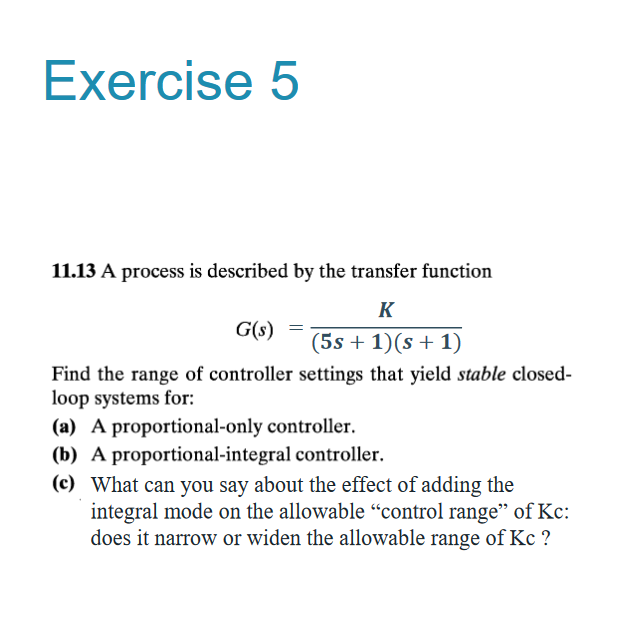Answered step by step
Verified Expert Solution
Question
1 Approved Answer
Is the solution provided below correct? Can you correct this one, and tell how to solve it ? We didn't work in class with imaginary
Is the solution provided below correct? Can you correct this one, and tell how to solve it We didn't work in class with imaginary parts. Exercise
A process is described by the transfer function
Find the range of controller settings that yield stable closed
loop systems for:
a A proportionalonly controller.
b A proportionalintegral controller.
c What can you say about the effect of adding the
integral mode on the allowable "control range" of Kc:
does it narrow or widen the allowable range of Exercise
a PROPORTIONALONLY CONTROL
requirement: with
control
and
order equation
C find noots by acdots
We know that only noots with real parts are stable!
S
for whatever value of
this noot will always be
however
only positive values of
are allowed by
This conodition is more smingent than and thes prevails
and thes prevails b PROPORTIONAL INTEGRAL CONTROC
requinement: with
PI
We know that only roots with real parts are stable!
For polynomials with order this holds twe only if
all coefficients in the polynomial are positive rulefrome
values are alway positive by
definition
The condition of is more stringeut
than only gnarantees stable conditions! A process control system contains the following transfer functions: e ss Gps es s e Ga Show how Gols can be approximated by a FOPTD model; Ke Find K T and fer function for the openloop process transb Use Routh stability methods and your FOPTD model to find the range of Ke values that will yield a stable closedloop system. Repeat for the fullorder model using MATLAB. c Determine Kem and the corresponding w

Step by Step Solution
There are 3 Steps involved in it
Step: 1

Get Instant Access to Expert-Tailored Solutions
See step-by-step solutions with expert insights and AI powered tools for academic success
Step: 2

Step: 3

Ace Your Homework with AI
Get the answers you need in no time with our AI-driven, step-by-step assistance
Get Started


